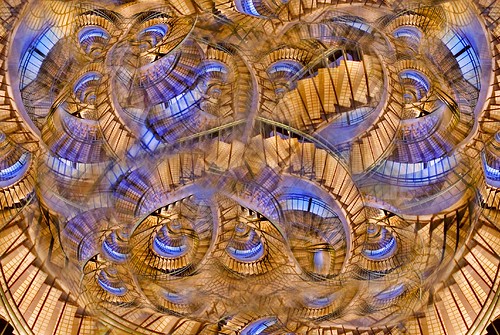My five-year-old son Nicky likes to ask me, “When is a door not a door?” Before I can answer, he tells me, “When it’s a jar,” and cackles wildly. In the same general spirit, I’d like to ask, when is a photograph not a photograph? My answer, and imagine me cackling wildly, is that a photograph is not just a photograph when it is a digital photograph.
View this image larger. Read the back story featuring this image.
How can this be? Literally, to photograph means to write with light. Off hand, we should be just as able to “write with light” whether the resulting images are saved to digital media or saved using silver halide chemistry.
But wait!
Each of the three images that illustrates this story depicts some kind of spiral. Each was created as a photo composite. The top image places a photo of a nautilus shell inside a photo of a spiral stair. The middle image combines several views of a nautilus shell with each other. The bottom image creates a dream (or nightmare) of one staircase contorted together with itself at different scales in an impossible way.
The general technique for photo compositing in Photoshop is to place the distinct images on separate layers, then use layer masks and blending modes to combine the layers. My own practice of compositing seems to often involve combining rotated or resized versions of the original photo, creating a kind of regression or recursion effect, as I explain in World without End.
View this image larger. Read the back story featuring this image.
OK, so most people recognize that a Photoshop photo composition is adding the element of composition, or collage, to straight in-camera photography. In fact, some purists don’t like Photoshopped photos for this reason. It can also be pointed out that it was certainly possible, if labor intensive, to create photo compositions using pre-digital technology (as a case in point, the great compositions of Jerry Uelsmann come to mind).
But an important point that seems forgotten is that every digital photograph has been post-processed. This post-processing may involve aggressive Photoshop work (or even as in the illustrations here the creation of entirely new composites). Or it may be the digital camera, that single-purpose computer with a lens and a scanner attached, automatically processes the scanner input into a file made up of pixels that it can save and display.
My own experience is that I spend far more time post-processing a photo than I do taking the photo in the first place. This is true for me even when the image doesn’t involve photo composition. Of course, if you are a production photographer processing (for example) hundreds of wedding photographs, you don’t have the luxury of this time. But I suspect that most serious photographers spend the couple of hours per image that I do in post-processing. In which case, how much of the resulting image is Photoshop and how much is photograph?
In fact, whether the post-process is under the control of the photographer, or whether the photographer is even aware of the post-processing, it does happen for every digital photo. In this sense, digital photography adds a whole new step to photography (I hate to use the overused “paradigm”, but it probably applies). It is no longer just photography, it is digitally post-processed photography. And the greatest transformation of photography since photography was invented.
View this image larger. Read the back story featuring this image.



Pingback: Photoblog 2.0: » Photoblog 2.0 Archive: » Hellebore on Black
Pingback: Photoblog 2.0: » Photoblog 2.0 Archive: » Making a Digital Collage
Pingback: Photoblog 2.0: » Photoblog 2.0 Archive: » Shine a Light on Digital Photography